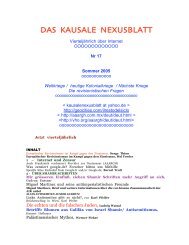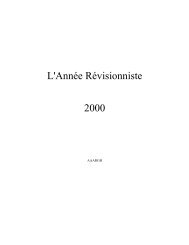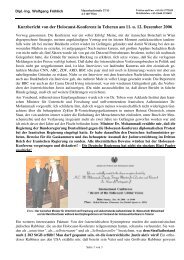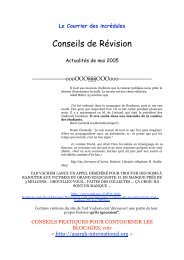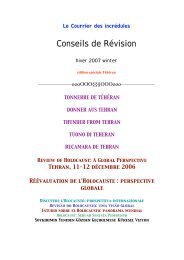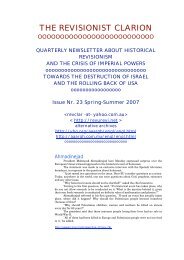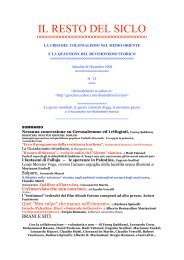Numéro 60--- ÃTà 2007 - Vho
Numéro 60--- ÃTà 2007 - Vho
Numéro 60--- ÃTà 2007 - Vho
Create successful ePaper yourself
Turn your PDF publications into a flip-book with our unique Google optimized e-Paper software.
GAZETTE DU GOLFE ET DES BANLIEUES / <strong>60</strong> / ÉTÉ <strong>2007</strong><br />
Israel's nuclear project was borne out of the tremendous fear of another Holocaust, which<br />
was a guiding light for the project's father, David Ben-Gurion, and that week in May may have<br />
been its most dramatic.<br />
Many of those involved saw themselves as partners in the making of a unique history.<br />
They were convinced that their activity signified a historic moment, and no politician, not<br />
even the prime minister, would be able to turn back the clock. Many of the recently published<br />
studies of the Six-Day War hinted at the fact that the Israeli nuclear dimension played an<br />
important but hidden role in the events leading up to the war, but none of the books has<br />
focused on this aspect. Layers of ambiguity, secrecy and taboo, in addition to censorship,<br />
prevented the story from coming to light. In my book Israel and the Bomb (1999), I tried to<br />
examine the crucial place of the Six-Day War in Israel's nuclear history. On the basis of<br />
commentary in Israeli and foreign publications, as well as additional documentary material, I<br />
suggested that it was on the eve of the war that Israel realized its nuclear option. Here, I will<br />
update that research. It should be noted that in the absence of official, authorized Israeli<br />
material, all of the assessments and conclusions made here are mine alone.<br />
According to all the estimates, Israel had almost completed the research and<br />
development stage of its nuclear plan during the year that preceded the Six-Day War. The<br />
main partners in the plan's development had acted separately from each other both<br />
organizationally and technologically, but now they were approaching the point of<br />
convergence. To oversee coordination of their work, halfway through 1966, the Atomic Energy<br />
Commission was reconstituted as an administration responsible for dealing with nuclear<br />
activity, under the management baton of Professor Israel Dostrovsky of the Weizmann Institute.<br />
Prime minister Levi Eshkol decided that he himself would chair the committee and hold the<br />
ministerial responsibility for its sensitive work. Despite the establishment of the commission, the<br />
political establishment still found it difficult to provide clear answers to the dilemmas that<br />
multiplied during the period preceding the Six-Day War. For the initial five nuclear countries<br />
(the United States, the Soviet Union, Britain, France and China), a successful nuclear test<br />
marked the transition from the infrastructure and R&D stage to the stage of building force and<br />
strategy. While such a test revealed the capabilities, it also publicly symbolized that the<br />
country had a nuclear political commitment. A test meant lifting the ambiguity surrounding<br />
the country's intentions. According to expert opinion, from a technological perspective, Israel<br />
could have followed this procedure in full during the second half of 1966. At that point, Israel<br />
could have joined the Nuclear Non-Proliferation Treaty (NPT) as a nuclear country in every<br />
respect.<br />
Delicate political consensus<br />
But Israel was different. As I wrote in Israel and the Bomb, as far as Eshkol was<br />
concerned, such a step was not a possibility. "What do you think, that the world will<br />
congratulate us for our achievements?" Eshkol would sarcastically demand of those who<br />
brought up the subject. And he had good reasons for thinking this way. Eshkol knew that the act<br />
of revelation would be a gross violation of the commitment he had made to the American<br />
administration that Israel would not be the first country to introduce nuclear weapons into the<br />
Middle East. Ben-Gurion had used this formula back in 1962, and afterward Shimon Peres<br />
used it as well, at an improvised meeting with president John F. Kennedy at the White House<br />
in April 1963. But the memorandum of understanding Eshkol signed in March 1965 with<br />
White House representative Robert Kommer turned this formula into an official Israeli<br />
commitment. Its precise meaning was vague, and Israel refrained from clarifying it. Eshkol,<br />
who fell in love with the formulation for exactly that reason, would, with a half-smile, ask the<br />
native English speakers around him (Abba Eban and Ya'akov Herzog) what exactly he was<br />
promising not to do in saying this.<br />
Everyone understood that a revelatory act would signify a gross violation of the Israeli<br />
commitment. Beyond that, Eshkol knew that the great powers were in an advanced stage of<br />
discussing an international nuclear nonproliferation pact. An Israeli revelatory act would<br />
therefore be tantamount to a challenge to those powers, which would result in a diplomatic<br />
catastrophe in the relations with the United States on which he had worked so hard.<br />
Furthermore, this commitment also had political significance inside Israel. The policy<br />
expressed a delicate internal Israeli consensus that the leaders of Ahdut Ha'avodah, one of the<br />
predecessors of Labor, especially Yisrael Galili and Yigal Allon, saw as a part of the sensitive<br />
coalition agreements still in place with Ben-Gurion. As far as they were concerned, this<br />
formula reflected a strategic Israeli interest and was no mere convenient and vague<br />
formulation. They believed that Israel had to develop a nuclear "capability," but not proceed<br />
— 15 —



